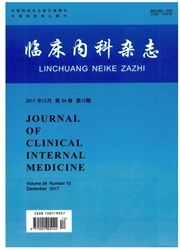

 中文摘要:
中文摘要:
目的 探讨长期深静脉留置透析导管相关性感染真菌谱、治疗转归及其易感因素。方法 选择2004年1月~2006年9月在我院行长期深静脉留置透析导管的患者24例次为观察对象,根据是否出现导管相关性真菌感染将24例次患者分为真菌感染组和非真菌感染组2组。观察并分析真菌感染发生率、临床表现、真菌培养、药物敏感试验、治疗转归及其相关易感因素。结果 (1)本组资料中导管相关性真菌感染发生率为20.83%,氟康唑导管内应用联合氟康唑封管治疗有效率为60%;(2)本组资料中感染真菌均为假丝酵母菌,治疗前对氟康唑敏感性最高;(3)导管相关性真菌感染与近期抗生素的应用、导管置入时间小于1年有关。结论导管相关性真菌感染是影响导管寿命的重要并发症之一,与近期抗生素的应用、导管置入时间小于1年有关,氟康唑导管内治疗部分有效。
 英文摘要:
英文摘要:
Objective To explore fungi species,effect of treatment and susceptible factors of infections related to permanent deep venous catheterization. Methods 24 hemodialysis patients who were indwelled deep venous catheter from Jan. 2004 to Sept. 2006 were enrolled. According to whether suffering with fungi infections or not, the patients were divided into two groups:fungi infection group and non-fungi infection group. Incidence, clinical manifestation, fungi species, drug susceptibihty, effect of treatment and susceptible factors were observed and analyzed. Results ( 1 ) The incidence of catheter-related fungi infections is 20.83% and the effective ratio of the treatment of fluconazole used from the catheter was 60% in the study. (2) In the study all of the infective fungi related to catheter were Candida mycoderma, which were the most susceptible to fluconazole according to the drug sensitivity test. (3) Catheter-related fungi infections were related to the recent usage of antibiotics and indwelling catheters less than 12 months. Conclusion The catheter-related fungi infection is one of the most important complications which influence the dysfunction of catheters. It is related to the factors such as recent usage of antibiotics and indwelling catheters less than 12 months. The treatment of fluconazole used from the catheter is partly effective, which could be used for empirical medication.
 同期刊论文项目
同期刊论文项目
 同项目期刊论文
同项目期刊论文
 期刊信息
期刊信息
